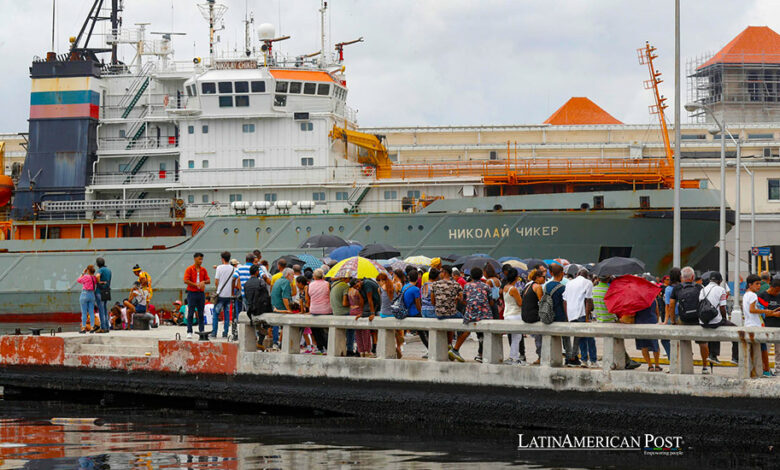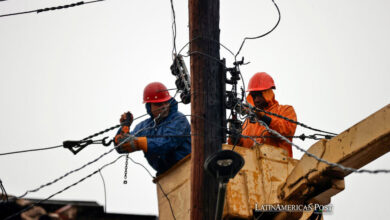Economic Crisis in Cuba Spurs Religious Revival and Migration

The severe economic crisis in Cuba has driven many, like retired teacher Elvira García, to seek solace in Afro-Cuban religions as they struggle with shortages, inflation, and the desire to reunite with family abroad.
When Cuban Elvira García knocked on the door of the Babalawo (Ifá priest), she was seeking answers in Afro-Cuban religion to her desperate situation. The retired teacher was at her wits’ end due to the severe shortages and inflation plaguing Cuba, her daughter’s illness, and the lack of available medicine. García also yearned to reunite with her family, who had emigrated to the United States, and she sought spiritual refuge from her loneliness and difficulties.
“I never practiced any religion, but when my daughter needed throat surgery and was very ill, I looked to the orishas for answers I couldn’t find in the earthly realm,” García explains.
García’s journey led her to the home of Babalawo Daniel Oliva, who asserts that her situation is not unique. A 46-year-old scholar of the Yoruba oracle, Oliva, told EFE he had witnessed a “religious explosion with the growth of believers due to the economic crisis of recent years” in Cuba. Experts and individuals connected to various religions on the island echo this sentiment, though official statistics by denomination are unavailable. Traditional beliefs, which may be practiced by up to one-third of Cubans according to some studies, often overlap with Christianity, complicating the numbers further.
“People are looking for a dream and see in religious places the possibility of being helped to achieve it,” Oliva explains from his home temple in Havana.
The link between crises and religious turnarounds is not new in Cuba. Oliva recalls a similar trend during the “special period” following the collapse of the socialist bloc in Eastern Europe, which led to a severe economic depression in Cuba. “Many people turned to religion regardless of the denomination—Yoruba, Christian, even Muslim—when the crisis of the 90s hit,” Oliva notes.
In Havana, it is expected to see groups of practitioners dressed in white gathering by the sea or riversides to perform rituals.
The Impact of Migration
Currently, Cuba is enduring its worst crisis in decades, characterized by frequent and prolonged power outages, food, medicine, and fuel shortages, rampant inflation, and an increasing dollarization of the economy. The pandemic, intensified U.S. sanctions, and failed economic policies have exacerbated the island’s structural economic problems.
This dire situation and a lack of prospects for medium-term recovery have triggered an unprecedented exodus over the past three years. Unofficial estimates suggest that about 7% of the Cuban population has emigrated. Since 2021, approximately 650,000 Cubans have moved to the United States, another 100,000 have gone to Mexico, and many more are heading to Spain, though they are harder to count due to dual nationality.
The dream of leaving Cuba for a better life is a recurring theme among those who consult Oliva. “Ifá (the father or guardian of secrets) has been hearing people’s pleas for years. Most come because they want to live a little better, and to do that, they need to emigrate,” explains the Cuban Babalawo.
This yearning for a better economic future drove Cuban chef Vladimir Blanes to turn to Orula (the orisha of the Ifá board and divination). “I faced several difficulties in achieving my dream, so my last chance seemed to be through religion,” the 36-year-old told EFE.
Seeking Economic Relief and Spiritual Solace
Oliva, however, is concerned about the increase in deceit, falsehoods, and lies amidst people’s suffering. He advises Cubans to “not lose faith and keep seeking aché” (a term akin to “luck” in Cuba) despite the crisis.
The religious revival in Cuba amidst economic turmoil mirrors a broader Latin American context, where financial crises often drive people toward spiritual solutions. Religion is crucial in communities in many Latin American countries, offering hope and a sense of control during economic instability. The resurgence of faith in Cuba is reminiscent of similar patterns seen during periods of financial hardship in countries like Brazil and Argentina, where people have historically turned to religion for comfort and guidance.
The economic crisis in Cuba is multifaceted, involving both internal and external factors. Internally, the Cuban government has struggled with economic reforms and maintaining a stable supply of essential goods. Externally, the U.S. embargo and recent sanctions have significantly impacted Cuba’s ability to trade and access necessary resources. This combination has led to widespread shortages and inflation, making everyday life increasingly difficult for ordinary Cubans.
Government Response and Public Sentiment
The Cuban government’s response to the crisis has implemented various measures, including rationing and seeking new trade partnerships. However, these efforts have often fallen short, and public sentiment has grown increasingly disillusioned. The government’s inability to provide necessities has driven many to look for alternative solutions, both spiritual and practical.
One notable aspect of the crisis is the growing use of the U.S. dollar in everyday transactions. The dollarization of the economy reflects a loss of confidence in the Cuban peso and highlights the extent of the island’s economic challenges. This shift has further exacerbated inequalities, as those with access to dollars can afford more goods and services than those relying on the national currency.
The economic crisis has also profoundly impacted Cuba’s healthcare system. The shortage of medicines and medical supplies has left many, like Elvira García’s daughter, struggling to receive necessary treatments. This has driven some Cubans to seek alternative and traditional forms of medicine, further illustrating the intersection of economic hardship and religious resurgence.
The situation in Cuba is not isolated but is part of a broader trend across Latin America. Economic crises have historically led to significant social and religious changes in the region. For example, during the financial crisis in Argentina in the early 2000s, there was a notable increase in the popularity of evangelical Christianity and other religious movements as people sought solace and support.
Similarly, in Brazil, economic instability has often been accompanied by a rise in religious engagement, particularly within Pentecostal and evangelical communities. These movements provide spiritual guidance, community support, and social services, filling gaps left by the state.
In Latin America, the economic crisis in Cuba underscores religion’s critical role in providing hope and resilience. As Cuba navigates its financial challenges, the interplay between faith and survival will likely remain a significant aspect of its social fabric.
Resilience Through Faith and Community
The economic crisis in Cuba has driven many, like Elvira García, to seek answers and solace in religion. This trend reflects a broader pattern across Latin America, where economic hardship often leads to a resurgence of faith. As Cuba faces ongoing challenges, the role of religion in providing hope, community, and a sense of control will remain crucial.
Also read: U.S. Condemns Cuba’s Protest Sentences Amid Own Crackdowns
The resilience shown by Cubans in turning to their spiritual beliefs highlights the enduring power of faith in times of crisis. Despite the difficulties, the message of not losing faith and continuing to seek aché offers hope for many on the island. As the economic situation evolves, the intersection of religion and daily life in Cuba will continue to be vital to the country’s response to adversity.





